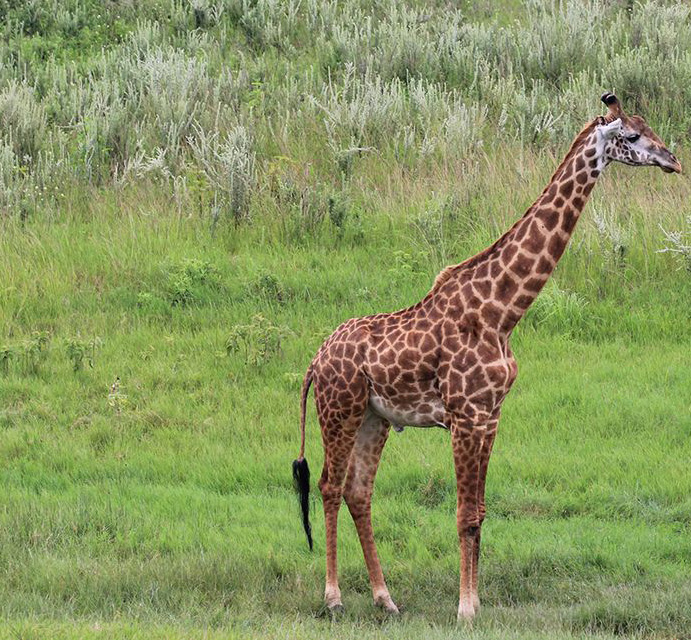Giraffa
IUCN
LCBasic Information
Scientific classification
- name:Giraffa
- Scientific Name:Kirin, Kirin Deer, Long-necked Deer
- Outline:Ungulata
- Family:Eutheria Artiodactyla Ruminantia Giraffidae Giraffa
Vital signs
- length:4-6 m
- Weight:Males weigh 900-2000 kg, females weigh 700-1300 kg
- lifetime:20-25 years old
Feature
The tallest living land animal in the world
Distribution and Habitat
There are nine subspecies of giraffes, all of which live in tropical and subtropical savannas, scrub, open acacia woodlands, dry and open savanna areas and semi-desert areas with sparse trees in Africa. They have no sense of territory, are sociable, and form loose groups with an activity area of between 5 and 650 square kilometers.
Appearance
Male giraffes are 4.5-6.1 meters tall, and female giraffes are 4.1-5.5 meters tall; males weigh 900-2000 kilograms, and females weigh 700-1300 kilograms; the average neck length is 2.4 meters; the height at birth is 1.8 meters; the weight at birth is 44-70 kilograms. Both males and females have a pair of small short horns covered with skin and fur on the top of their heads, with a light brown base color, which will not fall off throughout their lives. In addition, it has two pairs of horns behind its ears and eyes, but they are not very obvious. Some male giraffes also have a horn in the center of their foreheads. Therefore, they have 6-7 horns. The eyes are large and protruding, located on the top of the head, suitable for long-distance vision. In addition to a pair of large eyes that are natural "lookouts" for monitoring the enemy, they will also keep turning their ears to find the source of the sound until they determine that everything is safe before continuing to eat. Th
Details
Giraffes are the tallest animals in the world today. Their long necks stand tall, easily attracting people's interest.

Why is its neck so long? Some scientists believe that the neck of the giraffe's "ancestor" was not very long. Changes in the earth's crust, unfavorable living environment, frequent disasters, overflowing rivers, erupting volcanoes, lack of food on the ground... Only leaves on tall trees are available for them to pick. For food and survival, they have to keep lengthening their necks. Of course, this will take a long time, and the fittest will survive and the unfit will be eliminated. The neck of the giraffe has lengthened from generation to generation, 4.3 to 5.3 meters high from the foot to the top of the head. Some scientists disagree with this view.
The giraffe's neck is 3 meters long, which makes it easy for people to think that they have many vertebrae. But this is not the case. They actually have 7 vertebrae like us, but each vertebra can be up to 28 centimeters long. How about it, do you think you have learned more strange knowledge after reading it?
They are so big that we think they need a lot of sleep to get a good rest, but this is not the case. They need very little rest. A 5- to 7-minute nap between 2 and 3 hours a day is enough. In the wild, they can even sleep standing up so they can run away in case of danger. If they lie on the ground, their long necks form an arch.
The tongue of a giraffe is as long as its neck. This length can even reach 50 cm, which allows them to avoid thorns when eating their favorite food, acacia leaves. In addition, the tongue can be used as a cleaning tool and is used to clean the ears, drill into the nose or pull out thorns that have pierced the skin.
The spots on a giraffe's skin can indicate their age, especially in males. The darker the markings, the older they are. The color of the fur also indicates the sexual maturity of the males, and no two giraffes have the same spot pattern. Just like human fingerprints, these are very unique. This detail can be used to camouflage themselves, regulate temperature and recognize each other.
Due to the special shape of their furry mouths, giraffes are the only mammals that do not yawn. Their upper lip is not split like that of camels and is longer.
They can endure several days without water, because when they drink, they can drink up to 45 liters at a time. This allows them to spend up to three weeks in arid areas without tasting a drop of water.
In 2016, all giraffes were listed as vulnerable (VU) by the IUCN. As early as 2008, the nominate subspecies and the West African giraffe subspecies were already listed as endangered species.
In 2015 and 2016, the nominate giraffe was reintroduced into the South Bank Conservancy in Lake Mburo National Park and Murchison Falls National Park in Uganda.








